MV Dirona travel digest for Falmouth & Portland 2018

|
Click the travel log icon on the left to see these locations on a map,
with the complete log of our cruise. On the map page, clicking on a camera or text icon will display a picture and/or log entry for that location, and clicking on the smaller icons along the route will display latitude, longitude and other navigation data for that location. And a live map of our current route and most recent log entries always is available at //mvdirona.com/maps/LocationCurrent.html. |
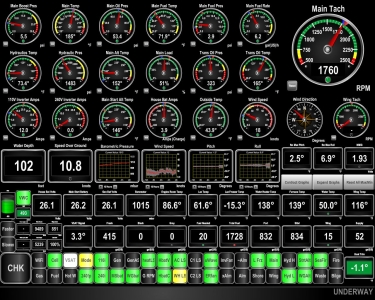 |
12/16/2017: 10.8 knots
Position: 53°7.19'N, -5°55.91'W
The winds finally settled down enough for us to make a 243nm run to Falmouth at the southwest corner of the UK. We left around midnight to catch favourable tides on our departure and around Land's End. Right now we're doing 10.8 knots as we run through the narrow channel west of India Bank. Normally we'd be doing just over 8 knots at 1760RPM.
|
 |
12/16/2017: Arklow Bank Wind Park
Position: 52°49.80'N, -5°52.71'W
We just northeast of the 25 megawatt Arklow Bank Wind Park. Commissioned in 2004, it is Ireland's first offshore wind farm and the first in the world to use wind turbine's rated at over 3 megawatts.
|
 |
12/16/2017: Radar Image
Position: 52°49.53'N, -5°52.71'W
The Arklow Bank wind turbines make very good radar targets.
|
 |
12/16/2017: Sunrise
Position: 52°14.89'N, -5°52.46'W
A spectacular sunrise as we approach the south end of St. George's Channel.
|
 |
12/16/2017: Stena Europe
Position: 52°11.04'N, -5°52.85'W
The capable-looking Stena Europe on the run between Roslare, Ireland and Fishguard, South Wales.
|
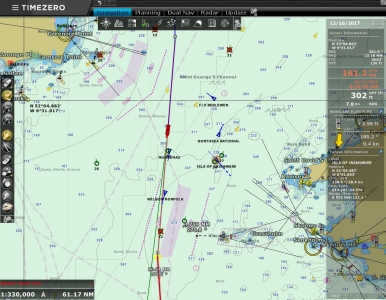 |
12/16/2017: Traffic
Position: 52°0.21'N, -5°54.27'W
Lots of traffic as we near the traffic separation lanes off St. Anne's Head.
|
 |
12/16/2017: 9500 Hours
Position: 51°52.49'N, -5°55.29'W
We just crossed 9,500 hours on our John Deere 6068AFM75 main engine.
|
 |
12/16/2017: 25.9 Degrees
Position: 51°29.97'N, -5°55.82'W
We were expecting winds up to 20 knots and seas mostly behind us. But we've been seeing steady winds up to 30 knots and big beam seas resulting in significant roll despite the stabilizers and we just rolled 25.9°.
|
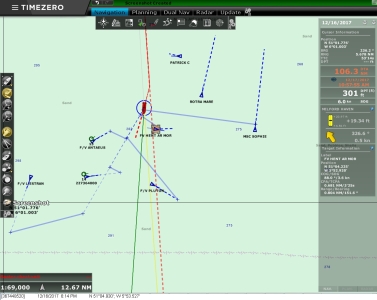 |
12/16/2017: Course Change
Position: 51°5.08'N, -5°53.48'W
We had to change course to avoid heavy traffic just north of Land's End. The dashed red line is where we intended to go and the blue lines with x's on each end are CPA (closest point of approach) lines that our chartplotter, TimeZero, draws. Each CPA line shows where Dirona and the target ship will be at the closest point between the two. At night we try to maintain a 2-mile CPA to other ships, but can't always achieve that if traffic is as heavy as it is now. We've diverted off course to the west and the CPA/TCPA information at the bottom right of the screen shot shows the closest we'll get to the fishing vessel Hent Ar Mor directly to our south will be 0.691nm in 3 minutes, 25 seconds.
|
 |
12/17/2017: Land's End
Position: 50°2.33'N, -5°48.63'W
We're approaching Land's End just outside the traffic separation lanes at 3:52am. You can see we had to make another course adjustment to avoid the fishing vessel Intuition directly to our north.
|
 |
12/17/2017: Conditions
Position: 49°59.09'N, -5°37.18'W
The roll graph shows that conditions have improved markedly, a combination of turning the corner at Land's End and putting the waves on our stern, and falling winds.
|
 |
12/17/2017: Pendennis Castle
Position: 50°7.62'N, -5°2.07'W
Pendennis Castle was built by Henry VIII in the 1500s to defend Cornwall from foreign invasion. The castle stands above Falmouth and will be the launching point for their New Year's Eve fireworks display.
|
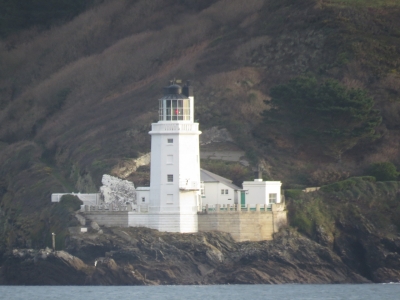 |
12/17/2017: St. Anthony Lighthouse
Position: 50°7.72'N, -5°2.08'W
St. Anthony Lighthouse was built in 1835 and was the Fraggle Rock Lighthouse in UK version of Jim Hensen's Fraggle Rock puppet television series.
|
 |
12/17/2017: Pendennis Shipyard
Position: 50°9.41'N, -5°2.43'W
Pendennis Shipyard is a superyacht builder in Falmouth that has averaged one ship a year, mostly large sailing yachts, over the past 30 years.
|
 |
12/17/2017: Rowing Santas
Position: 50°9.45'N, -5°2.96'W
A boatload of Santas rowing past Pendennis Shipyard as we approach Falmouth.
|
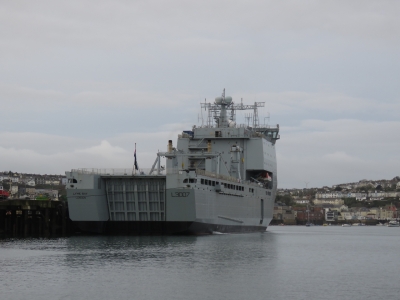 |
12/17/2017: RFA Lyme Bay
Position: 50°9.46'N, -5°3.11'W
The British landing ship dock RFA Lyme Bay moored at Port Falmouth.
|
 |
12/17/2017: Approach
Position: 50°9.28'N, -5°3.67'W
The distinctive tower in the distance as we approach the marina is the National Maritime Museum. The RFA Argus is on the left.
|
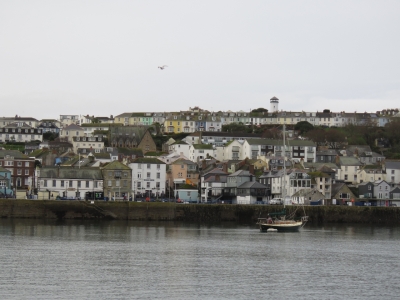 |
12/17/2017: Falmouth
Position: 50°9.28'N, -5°3.67'W
The town of Falmouth is packed with buildings right up to the waterfront.
|
 |
12/17/2017: First Smell
Position: 50°9.14'N, -5°3.66'W
Spitfire getting his first smell of Falmouth while eying the RFA Argus. He doesn't like other boats getting too close.
|
 |
12/17/2017: Port Pendennis Marina
Position: 50°9.09'N, -5°3.66'W
Our home for the next couple of weeks at Port Pendennis Marina with the RFA Argus beyond.
|
 |
12/17/2017: Lock
Position: 50°9.09'N, -5°3.63'W
The lock into the ultra-protected inner basin at Port Pendennis Marina.
|
 |
12/17/2017: RNLI
Position: 50°9.08'N, -5°3.56'W
We're once again within sight of an RNLI boat, this one the RNLB Richard Cox Scott. Dirona is moored just out of sight on the left.
|
 |
12/17/2017: Chain Locker
Position: 50°9.16'N, -5°3.95'W
We've been looking forward to visiting the Chain Locker since reading about Braun and Tina Jones' visit to Falmouth on their Nordhavn 64 Ocean Pearl. The Chain Locker was established in the 1700s and operates in one of Falmouth's oldest buildings. The pub just re-opened in September after a two-year renovation when it was found in danger of collapse. We had an excellent lunch there with a view to the harbour.
|
 |
12/17/2017: King's Pipe
Position: 50°9.12'N, -5°3.92'W
The King's Pipe near the Chain Locker was formerly used to burn contraband tobacco.
|
 |
12/17/2017: The Stable
Position: 50°9.14'N, -5°3.94'W
Falmouth has a large number of restaurants and pubs. We frequented The Stable for their excellent Smithwicks Scorcher pizza. The Stable specializes in ciders and has close to a dozen on tap.
|
 |
12/17/2017: Arwenack Street
Position: 50°9.13'N, -5°3.95'W
Arwenack Street in downtown Falmouth lit up for the holiday season. Falmouth is crazy-busy in the summer, but quite laid-back and uncrowded in the winter. We're loving it.
|
 |
12/18/2017: Morning
Position: 50°9.13'N, -5°3.65'W
A lovely calm first morning in Falmouth looking north across Port Pendennis Marina to Carrick Roads with the town of Falmouth on the left.
|
 |
12/18/2017: Island Time
Position: 50°9.13'N, -5°3.65'W
Spitfire getting in what we call some "Island Time" sleeping on the pilot house island.
|
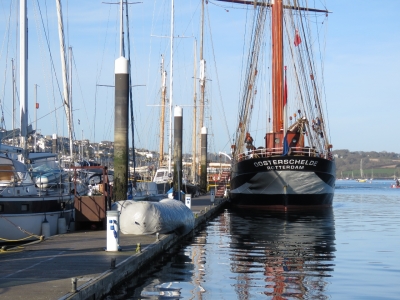 |
12/18/2017: Oosterschelde
Position: 50°9.13'N, -5°3.65'W
Oosterschelde of Rotterdam, behind us at Port Pendennis Marina, was launched in 1918 and restored eighty years later. It is the last of the Dutch-flagged early 20th-century sailing schooners still on the water.
|
 |
12/18/2017: Thai Orchid
Position: 50°9.40'N, -5°4.30'W
An excellent dinner at Thai Orchid in Falmouth. The restaurant was beautifully decorated, with colorful carpets and art filling the walls. We had a wonderful private table in a small nook off to one side.
|
 |
12/19/2017: Bungee
Position: 50°9.13'N, -5°3.65'W
We have two stacks of Really Useful Boxes in our lazarette, secured with bungee cords to prevent them from sliding around at sea. We noticed that the wire hook portion on starboard-side stack had stretched out (bottom of photo where wire attaches to cord), indicating extreme load. Likely that was from the 25.9° roll we experienced on the way to Falmouth.
|
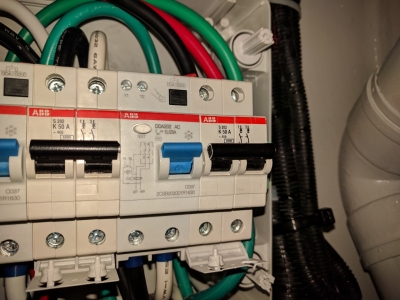 |
12/19/2017: Breakers
Position: 50°9.13'N, -5°3.65'W
The shorepower breaker released earlier today. On reset, it repeatedly released. We checked for ground faults and found nothing but when we switched the Residual Current Device (the blue handled unit beside the breaker) off and back on the problem cleared. We'll order two spare RCDs when we are in Southampton and replace this one.
|
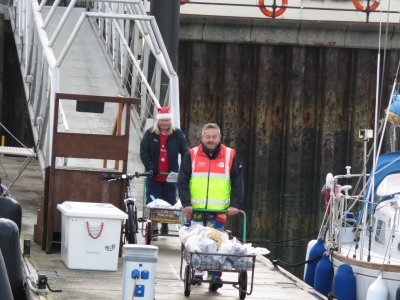 |
12/19/2017: Tesco
Position: 50°9.13'N, -5°3.65'W
Tesco arriving with two cartloads of groceries, including a frozen turkey for our Christmas dinner.
|
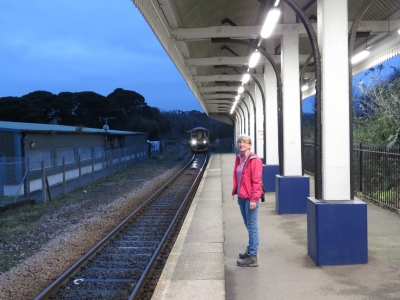 |
12/21/2017: Falmouth Docks
Position: 50°9.05'N, -5°3.35'W
Waiting at the Falmouth Docks train station on a day trip to Plymouth to visit our friends Jean and Matt Findlay. The station is the end of the line, so the train you can see arriving will stop here and then the engineer switches ends to depart.
|
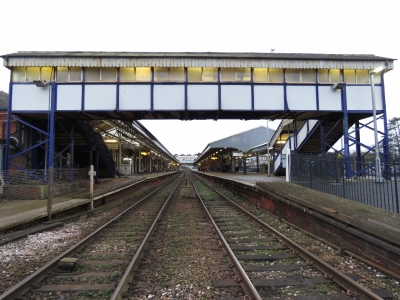 |
12/21/2017: Truro
Position: 50°15.84'N, -5°3.78'W
To reach Plymouth from Falmouth, we had to change trains in Truro so we took a bit of a walk around in between trains.
|
 |
12/21/2017: Royal William Yard
Position: 50°21.72'N, -4°9.96'W
Jean and Matt Findlay met us at the station and took us around to see some of the sights. The 16-acre Royal William Victualling Yard was completed in 1835 and was the main victualling yard for the Royal Navy. The original buildings now are being converted into upscale apartments and restaurants. The area reminded us very much of the Charlestown Navy Yard in Boston, built by the US Navy in 1801.
|
 |
12/21/2017: Drake's Island
Position: 50°21.59'N, -4°9.83'W
Drake's Island is named after Sir Francis Drake, whose home port was Plymouth. The visible structures are a defensive battery built in the late 1800s.
|
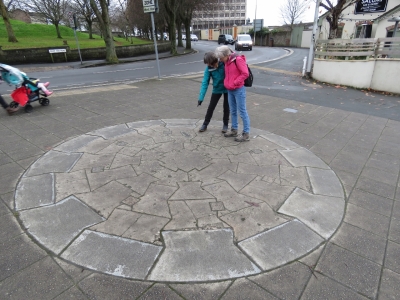 |
12/21/2017: Dovetailing
Position: 50°22.06'N, -4°9.04'W
Jean Findlay showing Jennifer a reproduction of how the Smeaton's Tower, a lighthouse, was built using granite blocks arranged in a dovetail fashion.
|
 |
12/21/2017: Sir Francis Drake
Position: 50°21.90'N, -4°8.59'W
Memorial to Plymouth resident Sir Francis Drake with the Plymouth Naval Memorial in the background. Between 1577 to 1580, Drake completed the second circumnavigation of the world in a single expedition.
|
 |
12/21/2017: Smeaton's Tower
Position: 50°21.86'N, -4°8.51'W
Smeaton's Tower was the third of four lighthouses built on treacherous Eddystone Reef, 14 miles southwest of Plymouth. The first light, completed in 1698, was swept away in the 'Great Storm' of November 1703. The second light operated from 1708 until 1755 when the lantern caught fire and destroyed the lighthouse. Smeaton's Tower was completed in 1759 and operated until 1882. The sea was undermining the rock it stood on, so the fourth and current light replaced it in 1882, built at a slightly different location. The original Smeaton's Tower was dismantled and moved to its current location.
|
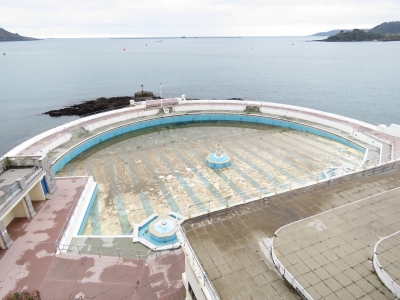 |
12/21/2017: Tinside Lido
Position: 50°21.81'N, -4°8.52'W
We've not seen an outdoor saltwater pool since the Wave Lagoon in Darwin, Australia. The Tinside Lido at Plymouth is apparently quite popular in the summer, but the water has to be awfully cold.
|
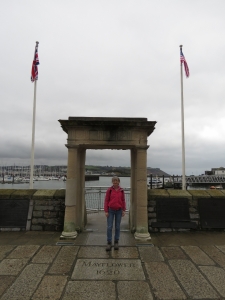 |
12/21/2017: Mayflower
Position: 50°21.97'N, -4°8.03'W
Jennifer standing at the Mayflower gate. The Mayflower sailed from Plymouth UK in 1620 to bring settlers to New Plymouth in the New World. We visited 'New Plymouth' and toured a replica of the Mayflower while we were in Boston in 2016, so now we've seen both ends of the journey.
|
 |
12/21/2017: Jean & Matt Findlay
Position: 50°21.96'N, -4°8.10'W
We first met Jean and Matt Findlay on their Beneteau 57 Superted V in March of 2014 on Stewart Island in southern New Zealand. We crossed paths an amazing number of times after, but haven't seen them since Cape Town in December of 2015. Jean and Matt sold Superted V after completing a circumnavigation and now live near Plymouth. It was wonderful to see them again, and we had a great time catching up and exploring the town.
|
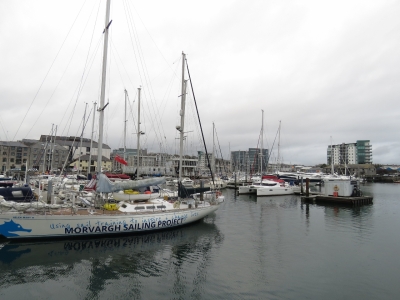 |
12/21/2017: Inner Harbour
Position: 50°22.06'N, -4°8.08'W
The Plymouth inner harbour is packed with marinas and boats.
|
 |
12/21/2017: Plymouth Gin
Position: 50°22.07'N, -4°8.26'W
Black Friars Distiller currently is the only producer of Plymouth Gin, a Protected Geographical Indication pertaining to any gin distilled in Plymouth, England.
|
 |
12/21/2017: Rick Stein's Fish
Position: 50°9.08'N, -5°3.78'W
After returning to Falmouth, we stopped in at Rick Stein's Fish for an exceptional meal.
|
 |
12/22/2017: KVH V7hts
Position: 50°9.13'N, -5°3.65'W
While in Dublin we upgraded to the latest KVH V7 satellite system, the KVH V7hts. The two highlights of the HTS (High Throughput Satellite) are 1) it's now a screaming 10Mbps rather than the previous 5Mbps and 2) it has a second channel for low speed batch traffic without metering cost. The speed is the exciting one, 10Mbps is faster than some cellular options. It's astoundingly good.
The intriguing option is what KVH calls the V7hts unlimited channel. The primary channel is the high speed channel and you pay for the data you move but on the unlimited channel, it's very slow but not metered. This channel runs at 128Kbps down and 64Bps up. We don't yet have a ton of experience with the UL channel but I'm intrigued by the possibilities. Read more ... |
 |
12/23/2017: Happy Holidays
Position: 50°9.13'N, -5°3.65'W
Wishing you all a Happy Holidays and best wishes for the New Year.
James, Jennifer & Spitfire |
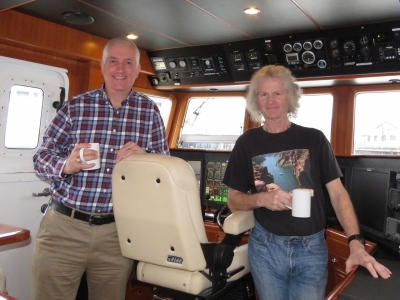 |
12/23/2017: Mike Green
Position: 50°9.13'N, -5°3.66'W
Nordhavn Dreamers discussion group moderator Mike Green lives in Plymouth and stopped by for a visit and a tour of Dirona. And he brought us a bottle of Plymouth Gin. Thanks Mike!
|
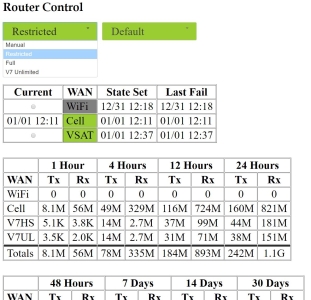 |
12/24/2017: Router Control
Position: 50°9.13'N, -5°3.65'W
Back in January of this year, we installed a Linksys R7000 router but it's about the furthest thing you can get from a R7000. Rather than running the Linksys protocol stack, we are running the open source DD-WRT system. Both are reliable firmware stacks but the open source system is nearly infinitely configurable. It's essentially a full Linux system with all the control of a Linux system but with the low level packet routing is done in hardware. The standard Linksys has, like most home routers, a single WAN port and several (in our case 4) LAN ports. We configured our R7000 to have 3 WAN ports and 2 LAN ports as well as the dual band WiFi radio system. The three WAN ports are: 1) WiFi, 2) Cellular, and 3) V7hts. The router automaticaly switches WANs to the least expensive connectivity available and it's been working well for the last year.
Router Control is the web application, pictured, that we wrote to change settings on the system. The app allows us to specify which of three wan ports we want to use or select full mode (auto select the least expensive), or restricted mode (auto select the least expensive but don't offer full connectivity on the satelite system since that can add up to real money quickly). We now have the V7hts system which actually has two available channels: 1) HS, the 10Mbps channel, and 2) UL, the unlimited channel that runs at 128Kbps. To accommodate our new satelite system we added a new WAN option: 1) WiFi Manual, 2) Cellular Manual, 3) V7hts HS channel, 4) V7hts UL channel, 5) full automatic, and 6) restricted automatic. The new option is the fourth of this list. We also updated Router Control to track the bytes moved through the the new V7hts UL channel as well as the other three WANs. |
 |
12/25/2017: Engine Work for Christmas
Position: 50°9.13'N, -5°3.65'W
We have had an intermittent engine control unit fault code on Dirona's John Deere 6068AFM75 for the past few months. Under higher loads or at idle when running the hydraulics, we sometimes get a 1347.7 fault code which indicates the actual fuel rail pressure is different from the called-for pressure. This is when the called for and actual pressure differs by more than 750 PSI (the system usually runs around 18,000 and at times is up over 20,000 PSI). The actual pressure could be 750PSI high or it could be 750PSI low, low the most probably explanation has the actual pressure low. The engine is normal in all ways with full power, no unusual smoke, or any other external sign so it's not having much impact on the engine's capabilities.
I've checked the suction control valve that is responsible for adjusting the fuel rail pressure at the high-pressure pump and the high-pressure relief valve and both are working as designed. At this point, the most likely explanations are 1) worn injectors or 2) internal leaks at the side tubes or injectors leading to excessive leak down and insufficient pressure under some circumstances. We've been busy having fun but we do have some time today, so we decided to open up the engine. We also have a minor oil leak at the rocker arm carrier so since we're working on this part of the engine anyway, we'll also take off the carrier, rocker arms, rocker shaft, and replace rocker arm carrier gasket and O-rings, adjust the valves, replace the injectors, replace the rocker cover gasket and carrier. |
 |
12/25/2017: Best Laid Plans
Position: 50°9.13'N, -5°3.65'W
Since we had been planning to change the injectors on Dirona's John Deere 6068AFM75 for the past few months, we had already ordered all the parts we needed that we didn't already carry. The parts we have to make the change are the rocker cover gasket and O-rings, rocker carrier gasket, and 6 new injectors. It's now Christmas, around noon, and I'm looking at 8 hardened O-rings that I didn't expect to need to change. In fact, I didn't know they existed. We have a prodigous supply of O-rings aboard Dirona, but our 6mm O-rings are 2.0mm in diameter while these are 2.5mm.
The O-rings we are missing are 6 O-rings to bring return fuel up from each injector to the rocker shaft carrier, 1 O-ring to bring pressure lubricating oil up from the cylinder head to the rocker shaft carrier and 1 O-ring to bring pressure oil from the rocker carrier to the rocker shaft hold down. It turns out the reason I missed these is that Deere 6068 engines mostly run these fluid flows through external piping but the 6068AFM75 and the newer 6068AFM85 use internal passages with O-rings. The O-rings do need to be changed, so we're going to need to wait until the Deere dealers open after the holidays. |
 |
12/26/2017: Chain Locker
Position: 50°9.16'N, -5°3.96'W
The view from the Chain Locker deck on a calm evening in Falmouth between weather systems.
|
 |
12/27/2017: Brush with Disaster
Position: 50°9.13'N, -5°3.65'W
A big storm passed through last night and the wind shot up from 15 to 56 knots in minutes, reminiscent of the brush with disaster we had in similar conditions in Richards Bay, South Africa. We didn't know it until the next day, but we also had a brush with disaster during the Falmouth storm. Two cleats broke off the boat moored upwind of Dirona and the local RNLI lifeboat was called during the middle of the night to tow it to safety before the remaining cleats let go.
Had that boat come loose and blown onto us, we'd certainly have sustained substantial damage. We're really impressed with the Port Pendennis Marina staff, who showed up on large numbers during the storm, checked all the boats and lines, added fenders to boats that were not adequately fendered, found the broken cleats on the boat behind us and called for lifeboat help. |
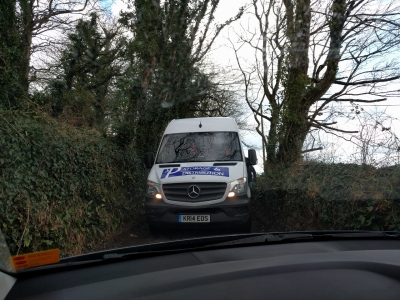 |
12/27/2017: Wedged
Position: 50°10.48'N, -5°24.66'W
It's December 27th and businesses are now open again so we got on the phone first thing this morning calling John Deere agricultural dealers. The good news is they had the parts we needed, but the bad news is they're about 45 minutes away by car, really not accessible by bus or train, and we can't find any rental cars in Falmouth. Kate Humphries from Melbourne, Australia came to rescue. She had arranged weeks ago to come visit us while we were in Falmouth. Kate had a rental car and generously offered to drive us to the Deere dealer.
Unfortunately the Hayle Bypass Google Maps directed us to was closed with no detour route set up. We generated new directions that ended up with our driving down progressively worse-quality roads until we ended up on a single-lane narrow road that actually crossed a running creek. And by cross a creek, we don't mean we drove over a bridge. We had to drive through the creek. Up a hill on the other side, we encountered a plug of traffic also rerouting around the closed bypass. This single-lane road, that likely gets very little traffic at all, suddenly is the replacement for the four-lane bypass. Rounding a bend, we came nose-to-nose with a large van. Hard to know who should back up. But a car showed up behind us, so we figured probably the van should back up. Then another van and several more vehicles showed up behind them. It looks like it's us that is backing. We worked our way backwards down the narrow road to where there was a large-enough gap at the creek that we could be passed. James sprinted ahead on the road to stop any more traffic and Kate sped after him in the rental car. All this for a few pence worth of O-rings. |
 |
12/27/2017: Mission Accomplished
Position: 50°8.58'N, -5°29.14'W
Kate Humphries and Jennifer outside the row of tractors at Cornwall Farm Machinery just outside Penzance. It was a bit of a goat rodeo getting here, but we finally got our parts. Time for lunch and a celebration.
|
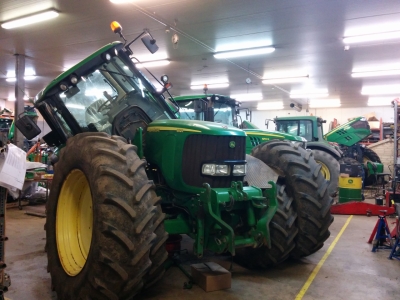 |
12/27/2017: Cornwall Farm Machinery
Position: 50°8.54'N, -5°29.10'W
Cornwall Farm Machinery was a wonderful stop. Partly because they had the 8 O-rings we need to be able to put our main engine back together and partly because they place is full of great green tractors—better than a modern technology museum. Almost all John Deere tractors working in the Cornwall area use the same 6068 base engine we have so there is no shortage of parts. The success of John Deere agriculture means there is almost always a dealer in area. Probably not a marine dealer but Deere skills are plentiful.
|
 |
12/27/2017: Dolphin Tavern
Position: 50°6.96'N, -5°31.86'W
Sizzling shrimp at the Dolphin Tavern in Penzance with Kate Humphries. Kate had sent us pictures of Dirona in front of the iconic Sydney Opera House minutes after we had dropped anchor for the first time in Sydney in December of 2014. She came to visit us in Melbourne in March of 2015, but we haven't seen her since. She happened to be in the UK visiting friends and it was great to be able to catch up half a world away. And, without Kate, our Deere might still be in parts in the engine room. Thanks Kate!
|
 |
12/28/2017: Engine Running
Position: 50°9.13'N, -5°3.65'W
Our Deere 6068 is now mostly back together, but the important thing is it starts well, runs well, sounds good, and smells good. After all this work, it's fun to watch it slowly warm up as I get ready to put the rest of the parts on after a short "coffee" break. We'll blog the details of the job.
|
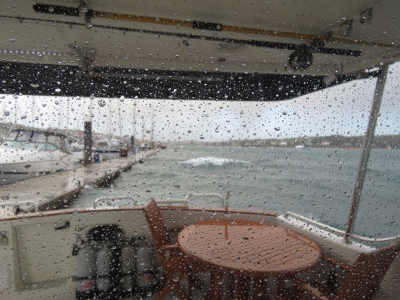 |
12/29/2017: Waves
Position: 50°9.13'N, -5°3.65'W
When big winds blow from the northwest, substantial waves roll towards the marina from Carrick Roads. Dirona is heavy so we don't move much, but the waves do make a bit of noise when they hit our stern.
|
 |
12/29/2017: 45 knots
Position: 50°9.12'N, -5°3.66'W
Another big winter storm in Falmouth bringing 45-knot gusts.
|
 |
1/1/2018: Happy New Year
Position: 50°9.13'N, -5°3.65'W
Falmouth put on an excellent New Year's Eve Fireworks display from Pendennis Castle right of our bow. This was one of the reasons we came to Falmouth for the holiday season. We had a great time ringing in the New Year while watching the display.
|
 |
1/1/2018: Lenovo L1900P
Position: 50°9.13'N, -5°3.65'W
Eight years ago we put 4 Lenovo L1900Ps in our pilot house and another in the salon and we bought a spare. In the Marquesas, French Polynesia back in 2013, we accidentally left open a hatch in rough water and the monitor in the master stateroom was damaged. We didn't have a spare for that one, so James replaced it using the spare Lenovo L1900P. With 6 of these Lenovo in service, we bought three spares which seems like more than we'll ever need but they are relativly inexpensive at just over $100 each. This morning, we got up to find one of our 4 monitors in the PH had failed. We replaced it quickly but, even though we have only had a single failure of the Lenovos, we decided to buy 2 more spares from Amazon. It's crazy to have 4 spares but with 6 in use and this monitor no longer in production, it seemed like the right thing to do.
|
 |
1/1/2018: Weather Window
Position: 50°9.13'N, -5°3.65'W
We're booked into the yard in Southampton on Jan 8th for routine maintenance. You would think a week would be plenty to travel the 200 miles from Falmouth, but big weather systems, some with 50kt winds, are forecast for most of next week. Looking at the XC Weather forecast for Falmouth, winds are expected to blow into the high 30s this afternoon, but we might have a lull starting tonight that is just long enough to travel partway, 120 miles to Portland, before a major system hits tomorrow afternoon. We'll monitor conditions and make a call later tonight.
|
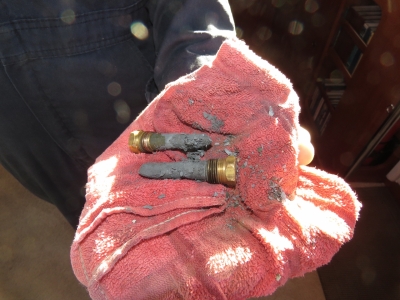 |
1/1/2018: Hydraulic Heat Exchanger Zincs
Position: 50°9.13'N, -5°3.65'W
We used to go through hydraulic heat exchanger zincs every six weeks. I tried unbonding the heat exchanger but I still need to change zincs every 6 to 8 weeks. The weird things is zinc life has been improving. They started looking good after 2 months, so we want to 3. Then they started looking great at 3 months, so we went to 4. This is after 5 1/2 months and they could easily have gone 6 months. Nice to see.
|
 |
1/1/2018: E1 Buoy
Position: 50°8.02'N, -5°1.40'W
10:30pm was the latest we felt we could leave Falmouth and safely reach Portland before the big weather system arrived around 6pm tomorrow afternoon. Conditions at E1 buoy, about 25 miles southeast of Falmouth, looked pretty bad early at 5pm with 27-kt winds and 14.4ft (4.4m) seas on a 9-second period. We didn't feel they could possibly settle down quickly enough for us to leave, but by 10pm they were down to 9.8ft (3m) on 9 seconds and the winds had fallen to 19kts. Still not ideal, but the wind and waves would be behind us, so we made the call to depart.
|
 |
1/1/2018: No Fault Code!!!!
Position: 50°7.89'N, -4°58.84'W
The engine was constantly producing fault codes at higher loads on the run from Dublin to Falmouth and we've now run at 2200rpm for more than an hour without a peep! Changing the injectors has solved the problem.
|
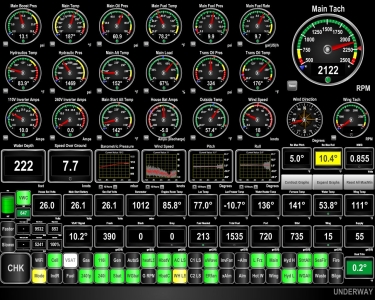 |
1/2/2018: Conditions, 12:49am
Position: 50°8.10'N, -4°36.08'W
As expected, the winds are about 20 knots with following seas about 10ft (3m) on 9 seconds. But they're both coming from behind, so we're seeing little pitch at just 5° and only the occasional roll to 10° when we catch a wave a little more on the beam. Conditions are better than we were expecting.
|
 |
1/2/2018: Eddystone Reef
Position: 50°8.23'N, -4°18.44'W
We're just passing south of the infamous Eddystone Reef, where four different lighthouse have been constructed, including Smeaton's Tower that we saw in Plymouth.
|
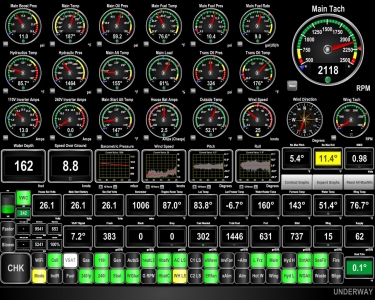 |
1/2/2018: Conditions, 9:51am
Position: 50°26.12'N, -2°33.27'W
We're about 3 hours out of Portland now and have made excellent time. Given the conditions, we'd expected to average only about 6.5 knots and arrive into Portland around 5pm. But we have instead averaged 8 knots and currently are running at 8.8 knots with a push from the current. We should arrive into Portland before 1pm. The winds have picked up a bit as expected and our max roll is creeping up, but the winds and seas still are behind us so it's not an uncomfortable ride.
|
 |
1/2/2018: Portland Race
Position: 50°28.88'N, -2°22.87'W
We're passing south of the infamous Portland Race. That passage between the Bill of Portland and The Shambles looks like an appealing shortcut, but currents there can reach 10 knots and even in much less current the seas can be dangerous. We passed well south of the race, but the seas picked up notably as the remains of the outgoing current met the 25-knot westerly winds.
|
 |
1/2/2018: Roll
Position: 50°29.44'N, -2°20.75'W
We're seeing bigger rolls, to 17.4°, as we turn northwest and Dirona is beam to the waves. But this won't last long as we'll soon be getting into the lee of the Bill of Portland to our west.
|
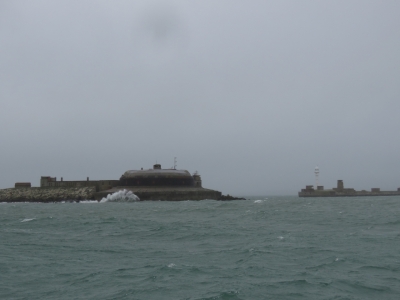 |
1/2/2018: Portland Harbour
Position: 50°35.09'N, -2°24.52'W
Portland Harbour, at 1,300 acres (520-hectares) was largest man-made harbour in the world when the British Navy completed it in 1872. It’s still the third-largest, behind 11,000-acre (500-hectare) Ras Laffan Harbour in Qatar and 3,700-acre (1,500-hectare) Cherbourg Harbour in France. The Portland Breakwater Fort, built in 1868-1875, and the Portland Breakwater Lighthouse, completed in 1905, flank the East Ship Channel into the harbour.
|
 |
1/2/2018: North Entrance
Position: 50°35.69'N, -2°26.05'W
Looking back to the fortifications along the south side of the North Channel into Portland Harbour. Only commercial traffic is allowed through the East Ship Channel—pleasure craft must use the North Channel.
|
 |
1/2/2018: Chain Knot
Position: 50°34.52'N, -2°26.79'W
Portland has a nice, new marina, but we preferred the simplicity of anchoring. And after our brush with disaster in Richards Bay, South Africa, we've learned that marinas aren't always a safer place in a storm, particularly for a big, heavy boat like Dirona.
We'd tucked in behind the marina breakwater to get good protection from the upcoming storm, with excellent holding, and were actually kind of looking forward to the storm. We've not anchored since the Isle of Gigha in Scotland over two months ago and after a few rough crossings, our anchor chain is in a complete knot. We've never had this happen before. We had to stop several times to release the tangles. |
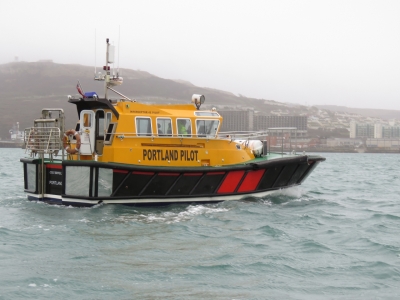 |
1/2/2018: Harbourmaster
Position: 50°34.52'N, -2°26.78'W
The Portland Harbourmaster sent a pilot boat over to ask if we were aware of the upcoming storm and to request that we move to the marina because Portland is not a protected harbour. We're not sure why they didn't contact us by VHF as we were monitoring 16, 13 and 74 (the harbourmaster's channel). We said we'd rather be at anchor and were told we'd need to maintain a constant listening watch on channel 74. This was a bit surprising as we'd read their pleasure craft leaflet, which made no mention of anchoring restrictions or the requirement to monitor channel 74.
We didn't want to move and probably could have stuck to our guns and stayed at anchor, but weren't keen on keeping the radio on all night. And if the authorities aren't happy with something, an enjoyable result doesn't usually follow. So we contacted Portland Marina and got a berth for a couple of nights. It's annoying the world third's largest harbour is so unwelcoming to recreational boats, but there wasn't a single boat anchored in the entire harbour. |
 |
1/2/2018: 2012 Olympic Sailing
Position: 50°35.09'N, -2°24.52'W
The 2012 Olympic Sailing events were held here in Portland Harbour not far from where we are docked. This is where Australian sailor Tom Slingsby won his Olympic gold medal in Lasers. We had watched Tom competing for Team Oracle in the America's Cup AC45 series in San Francisco in 2012 and met him in 2014 while we were visiting his hometown of Gosford, Australia. We watched him sailing Moths at Gosford and at Team Oracle Foiling Camp on nearby Lake Maquarie. While in Sydney Harbour during December of 2014, we watched Tom compete in the Extreme 40s Racing Series, and at the helm of Super Maxi Perpetual Loyal in the Big Boat Challenge and the Sydney Hobart Ocean Race. A few weeks later, we watched him compete in the 2015 Moth Worlds at Sorrento near Melbourne, and have since followed him in numerous races on TV or radio. It's fair to say we've become big fans over the years.
|
 |
1/2/2018: Storm Starting
Position: 50°34.41'N, -2°27.23'W
We're tied off on the visitor's pontoon at Portland Marina at 2:40pm. Right on schedule, the winds started to pickup around 6pm as the big storm neared. By 9pm, we had seen gusts to 49 knots and the winds were steady in the high 30s.
|
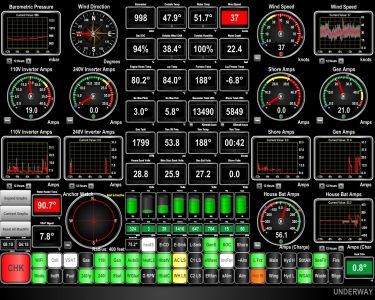 |
1/3/2018: 73 Knots
Position: 50°34.41'N, -2°27.23'W
Portland Marina is good and very strong but, wow, the winds are incredible. We saw gusts to 73 kts last night—the worse we have ever seen in a marina. The storm we saw in Richards Bay South Africa (A Brush With Disaster) was very similar but the peak wind speeds were less than this one.
Waves are breaking over the dock and the power is out in our area, probably because all the dock power pedestals have been under water for such a large percentage of the time. At 8:30am the wind still is never under 30 kts and often up over 50 kts. It's been like that or worse since the big gusts around 3am. The waves are so big in the relatively sheltered marina, surrounded by breakwaters, that the docks have a wave pattern in them with the dock hinges creaking back and forth. |
 |
1/3/2018: Fenders
Position: 50°34.41'N, -2°27.23'W
We always tie the boat off super tight and it's now so loose that two of the fenders have blown up onto the walkway and you can see the large forward fender flying up in the wind. It’s time like this that we really like our 1-inch dock lines.
|
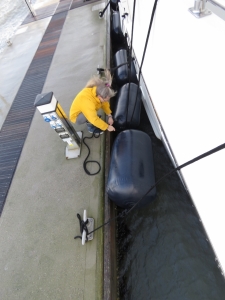 |
1/3/2018: Securing Fenders
Position: 50°34.41'N, -2°27.23'W
We ran small lines through the fenders, attaching them together, and tied the ends to cleats. That fixed the fender fly-away problem. You can see Jennifer's ponytail is almost horizontal in the wind.
|
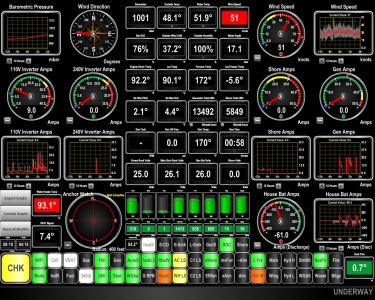 |
1/3/2018: 51 knots
Position: 50°34.41'N, -2°27.23'W
It's 11am and conditions still haven't settled down yet. The wind just hit 51 knots. The yellow check light in the bottom left hand of the screen is because the dock power is still out.
|
 |
1/3/2018: Checking Boats
Position: 50°34.41'N, -2°27.23'W
The Portland Marina staff were out checking lines on boats and adding more when needed. Notice how they are all leaning into the wind as they walk. At least one boat had come loose and hit another. Especially after that brush with disaster in Falmouth, we specifically put Dirona upwind of any boats that may come loose and blow down onto us.
|
 |
1/3/2018: Testing Connectors
Position: 50°34.41'N, -2°27.23'W
The dockside pedestals on the windward side were effectively underwater for a good part of the storm, so they are all leaking current and as a result the pier-end Residual Current Device (RCD) is releasing. We shut off all windward pedestal breakers since they aren't in use and the waves are constantly washing over them. After shutting these all off, the pier-end RCD stayed on but the shore RCD on the feed to Dirona still was releasing so we brought our shore power cord in form the storm to find our current leak. Unsurprisingly, the connector between the North American shore power cord on Dirona and the pigtail we use to connect to 32A European connectors, lying on the dock, was full of salt water and leaking enough current to trip the pedestal RCD.
Modern marinas use very sensitive RCDs which dramatically reduce the risk of electrical shock for those in the water near moored boats. Of course this is a good thing, but it has a nasty side-effect is that very small changes in insulation resistance that, in the old days would just work, now trip RCDs. We're currently plugged into a shore-side pedestal with a 30-milliamp RCD which means if there is 30/1000 of an amp leakage, it'll trip the breaker. There is also a 30-milliamp RCD on Dirona at the end of the shore power cord. Since this isn't popping, we know it's the shore power connector or the cord. |
 |
1/3/2018: Rinsing Connectors
Position: 50°34.41'N, -2°27.23'W
It looks crazy but here we're rinsing connectors in freshwater to wash out the salt water which causes corrosion and can lead to increased resistance and dangerous heat.
|
 |
1/3/2018: Drying Connectors
Position: 50°34.41'N, -2°27.23'W
After rinsing the salt water out of the connectors, we dried the freshwater since it also will provide an excellent path for electricity and we need to eliminate any current leaks before restoring the shore power on Dirona. We then checked the resistance between phase and ground and found we're back to effectively infinite resistance (no measurable current leak) so we're close to ready to go.
|
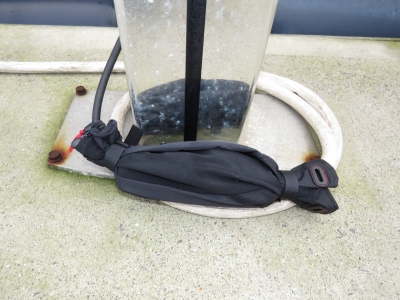 |
1/3/2018: Gaiter
Position: 50°34.41'N, -2°27.22'W
We had a spare alpine boot gaitor from sealing off the shore power cable retractor standpipe, and used it to protect the connection between our shorepower cable pug and the pigtail that adapts to to the local power source. This should help keep the connection dry when waves are washing over the dock.
|
 |
1/3/2018: Looking for Power
Position: 50°34.41'N, -2°27.23'W
James out with his power tester we built in Stornoway in the Outer Hebrides, looking for power in any of the dock pedestals. We now have a good pedestal connection that won't trip the pedestal RCD without our shore power plugged in. We have a clean and dry shore power connection without current leaks so it's ready to go. And, we have the pigtail to shore power connection protected from water intrusion. We plugged it all back in and shore power is back to working well.
|
 |
1/3/2018: Portland Marina
Position: 50°34.24'N, -2°27.10'W
Looking across Portland Marina from the office. Dirona is just visible roughly center in the distance.
|
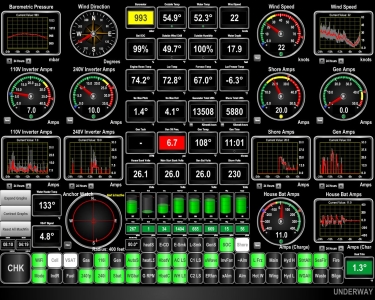 |
1/4/2018: Lull
Position: 50°34.41'N, -2°27.23'W
We had a brief lull in the winds around midnight, but not enough to allow us to make run the 60 miles to Southampton. By 5:30am the wind was climbing back up to 20+ knots as the next system approached. 20 knots is fine to travel in, but 30-40 knots will be here soon.
|
 |
1/4/2018: More Wind
Position: 50°34.41'N, -2°27.23'W
That second system intensified about about two hours ago as the winds shot up almost instantly to 30-40 knots. The winds shouldn't be quite as strong as the previous system.
|
 |
1/4/2018: Don & Sherrie
Position: 50°34.41'N, -2°27.23'W
Blog readers Don Herridge and his partner Sherrie live aboard Cheoy Lee LRC Outbound at Portland Marina. They noticed we were in the marina, and in fact could see us from their pilot house, and came over for a visit and a tour.
|
 |
1/4/2018: The Boat That Rocks
Position: 50°34.23'N, -2°27.12'W
An enjoyable meal with a harbor view at The Boat That Rocks pub in the Portland Marina Complex. Other than to register with the marina, we've not left the docks with all the storm systems coming through.
|
 |
1/5/2018: AC Fan Capacitors
Position: 50°34.41'N, -2°27.23'W
We have temperature sensors in several places in the engine room to detect cooling problems early. A particularly important sensor is the stack housing sensor where, if the temperature in the stack starts to escalate, we get email and an on-dash warning. On our last overnight run we saw that warning. We stopped and restarted the ER fans and the problem cleared. Today we dug in to understand why the fans were sometimes working and sometimes not. We pulled the fans and found they they spin well and are powerful. The problem is they both sometimes blow and other times, well, they suck.
The way many single-phase AC power fans work is they have four sets of windings where the power is applied directly to two opposing windings and the other two are fed through a capacitor. The capacitor has the effect of shifting the phase of the AC current in those windings by 90 degrees. This puts a bias into the magnetic field the rotor is operating in such that it is being "pulled" around fairly strongly in a single direction. If the capacitor fails, the fan will usually still spin fine but it often will turn the wrong way. James went through all of our engine room fans and found that we had four faulty capacitors. Two of these are 7-year old fans whereas the other 2 are only 2 years old. The good news is the capacitors are cheap and under $3.00 each in single unit purchases, and only pennies when bought in volume. They are quite inexpensive, but the bad news is we don't have any on board. We stole some from other fans to keep the engine room fans operating correctly, but we'll need to get some 2.5uF, 250V capacitors in the near future. |
 |
1/5/2018: Leigh Albrecht
Position: 50°34.41'N, -2°27.23'W
Leigh Albrecht smoking across Portland Harbour off our bow in a Moth class sailing hydrofoil. Leigh placed 10th in the Silver fleet in the 2014 Moth World Championships held at Hayling Island, just east of Portsmouth.
|
 |
1/5/2018: Tony & Sarah
Position: 50°34.41'N, -2°27.22'W
Locals Tony & Sarah Birch have been following our blog and came by to meet us and tour Dirona. They operate Wareham Forest Tourist Park, about 25 miles from Portland, and keep a boat in Poole and a Viking 46 Sports Cruiser in the Bahamas where they have cruised for 40 years. Tony also is an ex-Royal Navy pilot who has flown out of the Portland area. It was great to meet them both and talk boats, cruising and airplanes.
|